Old Barrington Meeting House National Historic Site of Canada
Barrington Head, Nova Scotia

Exterior view
© Parks Canada Agency / Agence Parcs Canada.
Address :
Highway 3, Barrington Head, Nova Scotia
Recognition Statute:
Historic Sites and Monuments Act (R.S.C., 1985, c. H-4)
Designation Date:
1966-10-26
Dates:
-
1765 to 1765
(Construction)
Other Name(s):
-
Old Barrington Meeting House
(Designation Name)
Plaque(s)
Existing plaque: Highway 3, Barrington, Nova Scotia
Erected in 1765 by settlers from New England, this meeting house is one of the oldest surviving buildings in English-speaking Canada. For almost a century it served as the civic and religious centre for Barrington Township, after which its function was confined to religious activities. Both its exterior design, originally covered with clapboard, and its interior plan, with a pulpit facing the central door and surrounded on three sides by pews and an upper gallery, imitate meeting houses found throughout New England. Its plain appearance was intentional, reflecting the puritan rejection of worldly ostentation.
Description of Historic Place
Old Barrington Meeting House National Historic Site of Canada is an exceptional surviving example of the type of meeting house erected throughout New England and Atlantic Canada in the late 18th and early 19th centuries. Located in Barrington, Nova Scotia, this building combines religious with civic functions. It is a very simple but beautifully constructed wood frame structure, designed in the vernacular classicism of the era. Although modified over the years, it retains a high degree of integrity. The designation refers to both the interior and exterior of the building on its property.
Heritage Value
Old Barrington Meeting House was designated a national historic site of Canada because: this meeting house is one of the oldest surviving buildings in English-speaking Canada; both its exterior and its interior imitate meeting houses found throughout New England.
Erected in 1765 by settlers from New England, this meeting house served as the civic and religious centre for Barrington Township for almost a century, accommodating all Christian denominations. Its function was confined to religious activities until it was preserved as a museum in the late 20th century. Both its exterior, covered with clapboard, and its interior, with a pulpit facing the central door and surrounded on three sides by pews and an upper Gallery, imitate meeting houses found throughout New England. Its plain appearance was an intentional reflection of the Puritan rejections of worldly ostentation.
Source: Historic Sites and Monuments Board, Minutes, October 1966, June 1978.
Character-Defining Elements
The aspects of this site which contribute to its heritage value include: those elements which speak to its status as one of the oldest surviving buildings in English-speaking Canada, namely its vernacular design, its timber-frame construction and wood cladding, making use of local materials, its unadorned functionalism, its evolutive finishes with detailing and interior finishes added over the years, and the continued integrity of its structure; those elements which speak to its qualities as a meeting house, namely its timber frame construction and wood finishes, its rectangular volume with a gable roof, symmetrical elevation with evenly spaced, rectangular openings, its main entry on the long side under a front-sloping gable roof, the interior arrangement of space with locally constructed box pews centred on the high panelled pulpit which faces the entry, three-sided gallery, simple railed staircases, its vocabulary of classically-inspired mouldings, and its relationship with the nearby burying ground.